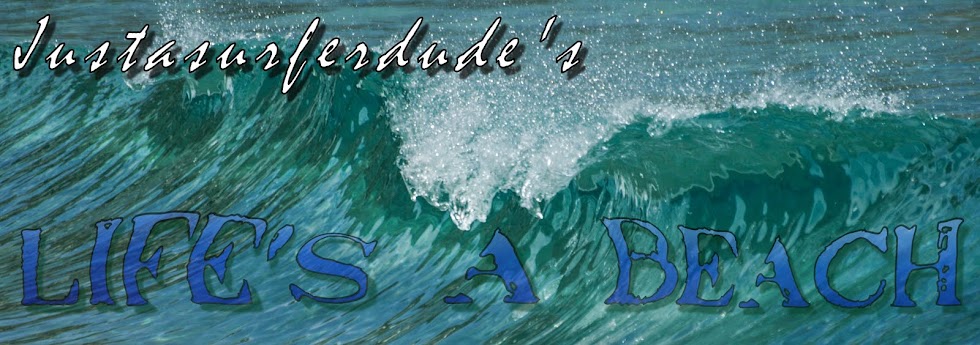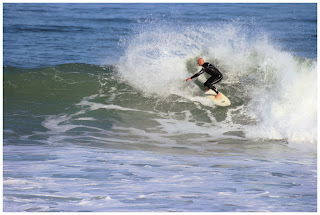I've noticed on my blog statistics that many people search for "dick diving" and then land up on my
post I did a while ago on this topic. I actually just put some nice pictures in the post, but I assume people are looking for this because they want to learn to duck dive and not want to see pretty pictures. Duck diving is NOT a pretty picture if you don't know what one's talking about or if you don't know how to execute it properly, so here are some tips.
Many years ago I had a friend who was rather competitive. He grew up far from the ocean but always said that he would be able to surf, that it cannot be that difficult. I took him to Durban where I grew up, gave him my board and said, there you go. What he didn't know was that duck-diving is as part of surfiing as climbing is as part of paragliding. After about 20 minutes of struggle to get out, he came back exhausted and admitted that surfing was not easy. He has not even been to the part where you have to stand up yet. I am no Kelly Slater or Jory Smith, but at least I have learned a few things about getting to the waves without having to rest for 20 minutes to get my breath back, so I hope I can help you.
1) The first thing you need to do before going out is to wait a second and look at the sets coming through. Rushing in just as a set is coming through will have you fighting against the waves and leaves you exhausted. Watch two or three sets coming through to see how long they take and how far they are apart of each other. As soon as the last wave brakes then start paddling in. You don't want to get pounded on your way in already, so be patient to get out.
2) If the next set comes and you are caught inside, do not fight the waves. Most people start paddling harder with the hope of missing probably only the last wave, leaving then exhausted and unable to continue paddling. The best way is to relax and to wait for the waves to come through. You don't have to move forward, all you need to do is stay at least at the same spot. Keep your slow paddling pace and make sure that you do a proper dive at least so that you are not thrown backwards. Conserve your energy. When the sets is over you can continue going forward.
3) One of the worst things that could happen to you is when a wave breaks and you get hammered by the lip on your back or right in front of you. So, time yourself when paddling in so that this does not happen. This means that sometimes you have to stop paddling to get your timing right. It is much easier to duck-dive a foamie than to duck-dive a wave that is going to close out right in front of you or or your head.
4) In a worse case scenario as described above, there is no shame in "abandoning your ship" and diving underneath the wave. The dangers of this though is your leash breaking or your board hitting the dude behind you. So, always be aware where your mates are otherwise you might turn into one of their ex-mates. You are going to be pulled backwards when you do this, but it is still better than ending up with a broken back or broken board. If the set is too big, don't try and get back on your board and start fighting the waves again. Hang around and chill until the set has passed.
5) Although it is easier to learn surfing on a bigger board, it is harder to duck-dive. Make sure that you have enough weight and strenght to push the board down. Remember, one duck-dive is probably equivalent to five push-ups. Conserving your energy is very important. The best time to do the duck-dive is just before the waves peak going through the face of the wave. This way you are basically sucked in by the waves and propelled through to the back. Not much effort required.
7) Know your local break. There is usually the bowl or impact zone area where the waves break and an area where the water channels back. It is easier to paddle in the channel. If the are rocks or a pier, it is easier to paddle alongt those and then move over to the bowl once you are in. Never paddle straight to the line-up where the guys are taking the waves, you will either end up in front of them or get bopped out faster than what you've paddled in.
8) When you are paddling in and you are going to be met by a surfer on the face of the wave, stay calm and in one place. The surfer obvioulsy has mastered the art of surfing already and can manoevre around you. If you start splashing this way and that way a collison is inevitable. This is the time where you hang on to your board for dear life and forget about the option I've mentioned in point 4. It is better to be sworn at afterwards than to be hit by a surfboard, to damage two boards in the process and then to be sworn at. Oh, and if you were in the way, there is no harm is saying sorry.
So these are some of the basics to make duck-diving easier. But what about the actual duck-dive itself? There are many ways to skin a cat and probably many way to duck a wave, but this is what works for me.
1) One thing you have to remember is that when you push down your board in the wave it reacts like a ironing board in a wind tunnel. You have to keep it straight into the flow and allow the water to pass. If you don't do that the wave will push you back and spit you out. The best way to do this is to keep the board in line with the water flow; push it too deep and you will topple forward, keep too upright and you will be pushed back along with the board.
2) There are two ways to help you getting the board down. You can either use your one knee or you foot if the board is long enough, while lifting your upper body up as if you are going to do a push-up. Use your other leg to keep your body in line with the board, like an aircrafts back fin. You will see in the pictures on my
previous post that everyone has a leg in the air, except for that last pic of the girl on the bodyboard. We'll excuse her this time.
3) Once you are under the water, your body will separate from your board. Just hold onto it allowing the water to flow past. This part is like learning to ride a bicycle. It takes practice. As you reach the surface again, your board will move towards your body again.
I hope some of what I said can help you. In the end practice is all you need. Just don't give up. Unfortunately for everything nice there is a part that we need to do that we don't like. For me, besides having to put on a wetsuit because of the cold water, duck-diving is probably it. I am sure there are many more sites on the Internet to teach you the basics, but in the end you have to go down there and do it. Have fun!








